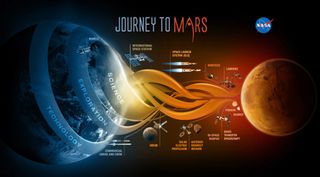Legislation Would Require Strategic Plan for NASA Human Spaceflight

WASHINGTON — Legislation recently introduced in the House and Senate would require NASA to develop a detailed studyabout how it would achieve a long-term goal of humans on Mars.
The Mapping a New and Innovative Focus on our Exploration Strategy (MANIFEST) for Human Spaceflight Act, jointly introduced Jan. 24 by Sen. John Cornyn (R-Texas) and Rep. John Culberson (R-Texas), is intended to build upon a 2014 National Academies report on human space exploration pathways.
The key portion of the bill would require NASA to develop a strategic plan for a series of missions leading up to human missions to Mars. It also amends a 2010 NASA authorization act, the most recent such bill to be enacted, by making "human exploration of Mars, including the establishment of a capability to extend human presence to the surface of Mars" a key goal of NASA's human spaceflight program. [NASA's Vision for Astronauts on Mars]
"By requiring a strategic plan from NASA, this bill will help focus existing resources towards achieving our long-term goal of landing a human on Mars," Cornyn said in a statement.
The report envisioned by the bill would cover a wide range of issues associated with human space exploration. They include descriptions and assessments of mission architectures using Orion and Space Launch System, use of the International Space Station to achieve exploration goals, partnerships with other countries or private industry, studies of crew health and safety.
The bill doesn't directly specify what should be intermediate missions prior to going to Mars, including human missions to the surface of the moon, but would require the report to assess such destinations.
One aspect of the report, according to the bill, is an examination of the "utility of an expanded human presence in cis-lunar space toward enabling missions to various lunar orbits, the lunar surface, asteroids, Mars, the moons of Mars, and other destinations of interest." The bill would also require the report to provide a "detailed plan for prioritizing and phasing" those intermediate destinations.
Get the Space.com Newsletter
Breaking space news, the latest updates on rocket launches, skywatching events and more!
Under the bill, NASA would be required to submit an interim report to the National Academies 90 days after the bill's enactment. The final version of the report, from the National Academies, is due one year after the bill becomes law. The bill stipulates that the process be repeated every five years.
"Americans are at their best when they're conquering new frontiers and this legislation ensures that NASA continues to push the boundaries of space exploration by landing an American astronaut on Mars," said Culberson in a statement.
This story was provided by SpaceNews, dedicated to covering all aspects of the space industry.
Join our Space Forums to keep talking space on the latest missions, night sky and more! And if you have a news tip, correction or comment, let us know at: community@space.com.

Jeff Foust is a Senior Staff Writer at SpaceNews, a space industry news magazine and website, where he writes about space policy, commercial spaceflight and other aerospace industry topics. Jeff has a Ph.D. in planetary sciences from the Massachusetts Institute of Technology and earned a bachelor's degree in geophysics and planetary science from the California Institute of Technology. You can see Jeff's latest projects by following him on Twitter.

